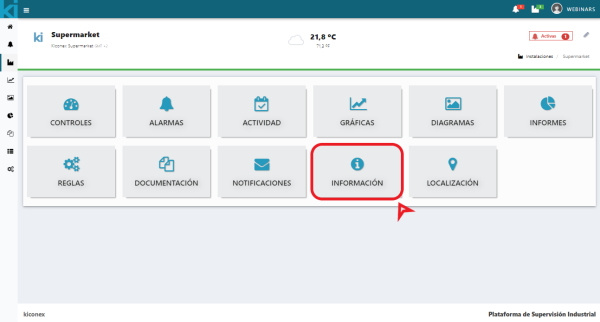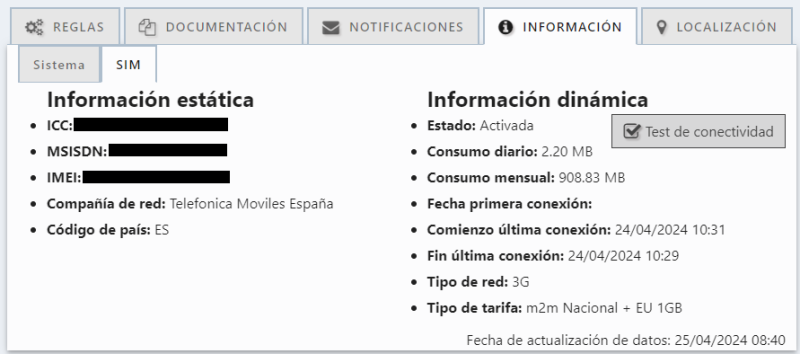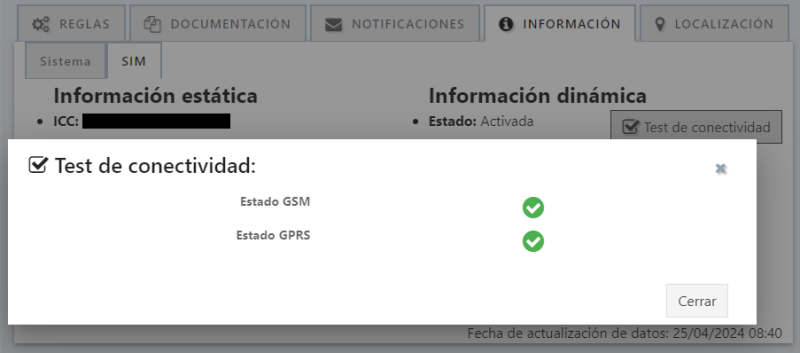Diferencia entre revisiones de «System/en»
Página creada con «== Hardware information == # '''Hardware model''': Indicates the model of internal electronic board that the ''kiBox'' has. # '''Commercial model''': Indicates the commercial model of the ''kiBox''. # '''Number of ports''': Indicates the number of RS485 ports the ''kiBox'' has. # '''Activity time''': Indicates the time the ''kiBox'' has been active while running the software. This time is reset if the equipment is restarted by turning the power off and on again. # '''…» |
Página creada con «The test is divided into GSM Status and GPRS Status, defining:» |
||
| (No se muestran 5 ediciones intermedias de 4 usuarios) | |||
| Línea 1: | Línea 1: | ||
__TOC__ | |||
== Information == | |||
In the information tab you can find all the information corresponding to the KiBox, network configuration, software version information, UUID, SIM information, among others. | |||
The information is separated by two tabs where you will find System and SIM. | |||
The | |||
The | <div class="mw-translate-fuzzy"> | ||
[[Archivo:SP - | The information tab can be accessed through the main menu or the main tabs. | ||
[[Archivo:SP - | [[Archivo:SP-MENU PRINCIPAL PESTAÑA INFORMACIÓN.png|centro|miniaturadeimagen|600x600px|Information tab in the main menu]] | ||
[[Archivo:SP-BARRA MENÚ PRINCIPAL PESTAÑA INFORMACIÓN.png|centro|miniaturadeimagen|600x600px|Information tab from the main bar of the installation]] | |||
</div> | |||
== Hardware information == | === Hardware information === | ||
# '''Hardware model''': Indicates the model of internal electronic board that the ''kiBox'' has. | # '''Hardware model'''': Indicates the model of internal electronic board that the ''kiBox'' has. | ||
# '''Commercial model''': Indicates the commercial model of the ''kiBox''. | # '''Commercial model'''': Indicates the commercial model of the ''kiBox''. | ||
# '''Number of ports''': Indicates the number of RS485 ports the ''kiBox'' has. | # '''Number of ports'''': Indicates the number of RS485 ports the ''kiBox'' has. | ||
# '''Activity time''': Indicates the time the ''kiBox'' has been active while running the software. This time is reset if the equipment is restarted by turning the power off and on again. | # '''Activity time'''': Indicates the time the ''kiBox'' has been active while running the software. This time is reset if the equipment is restarted by turning the power off and on again. | ||
# '''Temperature''': Indicates the internal temperature of the ''kiBox'' electronic board. | # '''Temperature''': Indicates the internal temperature of the ''kiBox'' electronic board. | ||
# '''Free RAM memory''': Indicates the free RAM memory. | # '''Free RAM memory''': Indicates the free RAM memory. | ||
# '''Free HDD''': Indicates the free space on the HDD hard disk. | # '''Free HDD''': Indicates the free space on the HDD hard disk. | ||
# '''Network interface''': Indicates the information of the network interfaces to which the ''kiBox'' is connected. There are eth0, eth0 and tun0, in each of them the obtained IP and the MAC address are indicated except in tun0 | # '''Network interface'''': Indicates the information of the network interfaces to which the ''kiBox'' is connected. There are eth0, eth0 and tun0, in each of them the obtained IP and the MAC address are indicated except in tun0 in which the MAC is not shown. | ||
[[Archivo:SP - Ej. Información del hardware.png|centro|miniaturadeimagen| | [[Archivo:SP - Ej. Información del hardware.png|centro|miniaturadeimagen|Ex. Hardware information]] | ||
== Software information == | === Software information === | ||
# '''Daemon | # '''Daemon version'''': Indicates the version of the kiDaemon service. | ||
# '''Operating system version''': Indicates the distribution and version of the operating system. | # '''Operating system version'''': Indicates the distribution and version of the operating system. | ||
# '''UUID''': Indicates the unique identifier of the | # '''Operating system name:'''' Indicates the name assigned to the operating system version. | ||
# '''UUID'''': Indicates the unique identifier of the installation. It has the option to copy to the clipboard for use in user registration, for example. | |||
# '''Daemon Date''': Indicates the date of the kiDaemon service version. It is important to always have the version as up to date as possible. | # '''Daemon Date''': Indicates the date of the kiDaemon service version. It is important to always have the version as up to date as possible. | ||
# '''Compilation options''': Gives information about what extra packages are included in that software version (e.g. location for GPS geolocation of the | # '''Compilation options''': Gives information about what extra packages are included in that software version (e.g. location for GPS geolocation of the installation).[[Archivo:SP - Ej. Información del Software.png|centro|miniaturadeimagen|Ex. Software information]] | ||
[[Archivo:SP - Ej. Información del Software.png|centro|miniaturadeimagen| | |||
== Data update date == | === Data update date === | ||
Indicates the date on which the data displayed in the system | Indicates the date on which the data displayed in the system have been updated, as well as the time. By clicking on the "refresh" button, the board is asked again for the last information. | ||
[[Archivo:SP - Ej. Fecha de actualización de datos.png|centro|miniaturadeimagen| | [[Archivo:SP - Ej. Fecha de actualización de datos.png|centro|miniaturadeimagen|Ex. Date of data update]] | ||
== SMS == | |||
In this section you will find all the information necessary to manage the status of your installation's SIM card. | |||
SIM information is divided into static and dynamic information. | |||
[[Archivo:SP-PESTAÑA SIM.png|centro|miniaturadeimagen|800x800px|SIM tab content]] | |||
=== Static Information === | |||
This information, as its name indicates, is static, it is the information that cannot be modified and will always be the same. It comes from the information that the operator assigns to the SIM card. | |||
* '''ICC''': is the international identifier associated with the SIM card. | |||
* '''MSISDN''': is the international telephone number associated with a SIM card. | |||
* '''IMEI''': is the unique identifier associated with the mobile terminal that identifies the hardware of the communications module. | |||
* '''Network company''': is the name of the operator with which the M2M SIM card works. | |||
* '''Country code:''' indicates the code of the country in which the M2M SIM card is operating. | |||
<span id="Información_Dinámica"></span> | |||
=== Dynamic Information === | |||
* '''State''': is the international identifier associated with the SIM card. | |||
* '''Daily consumption''': indicates the current consumption of the purchased rate. | |||
* '''Monthly consumption''': indicates the consumption of the current month. | |||
* '''First connection date''': is the date on which the Client changes the SIM card to the Activated state for the first time. | |||
* '''Start of last connection''': is the date of the beginning of the last connection period of the SIM card. | |||
* '''End of last connection:''' is the date of the last connection of the SIM card. | |||
* '''Network type:''' indicates which network is being used by the SIM card. | |||
* '''Rate type''': is the name of the rate associated with the SIM card. | |||
=== Connectivity Test === | |||
[[Archivo:SP-TEST DE CONECTIVIDAD.png|centro|miniaturadeimagen|Connectivity Test Button]] | |||
The connectivity test allows you to run diagnostic operations on a SIM card in order to identify problematic situations with the card. | |||
The test is divided into GSM Status and GPRS Status, defining: | |||
* '''GSM Status''': returns information about the current status of the SIM card registration in the network if it is OK or a warning. | |||
* '''GPRS Status''': returns information about the current status of the SIM card with respect to the establishment of the data session if it is OK or if it is an error. | |||
[[Archivo:SP-TEST DE CONECTIVIDAD POSITIVO.png|centro|miniaturadeimagen|800x800px|E.g. positive connectivity test]] | |||
It should be noted that you can only obtain this data if you have purchased a kiconex rate. To obtain your rate, you must contact the kiconex sales department (sales@kiconex.es) where they will offer you the best option for your needs. | |||
Revisión actual - 14:05 27 ago 2024
Information
In the information tab you can find all the information corresponding to the KiBox, network configuration, software version information, UUID, SIM information, among others.
The information is separated by two tabs where you will find System and SIM.
The information tab can be accessed through the main menu or the main tabs.


Hardware information
- Hardware model': Indicates the model of internal electronic board that the kiBox has.
- Commercial model': Indicates the commercial model of the kiBox.
- Number of ports': Indicates the number of RS485 ports the kiBox has.
- Activity time': Indicates the time the kiBox has been active while running the software. This time is reset if the equipment is restarted by turning the power off and on again.
- Temperature: Indicates the internal temperature of the kiBox electronic board.
- Free RAM memory: Indicates the free RAM memory.
- Free HDD: Indicates the free space on the HDD hard disk.
- Network interface': Indicates the information of the network interfaces to which the kiBox is connected. There are eth0, eth0 and tun0, in each of them the obtained IP and the MAC address are indicated except in tun0 in which the MAC is not shown.

Software information
- Daemon version': Indicates the version of the kiDaemon service.
- Operating system version': Indicates the distribution and version of the operating system.
- Operating system name:' Indicates the name assigned to the operating system version.
- UUID': Indicates the unique identifier of the installation. It has the option to copy to the clipboard for use in user registration, for example.
- Daemon Date: Indicates the date of the kiDaemon service version. It is important to always have the version as up to date as possible.
- Compilation options: Gives information about what extra packages are included in that software version (e.g. location for GPS geolocation of the installation).

Ex. Software information
Data update date
Indicates the date on which the data displayed in the system have been updated, as well as the time. By clicking on the "refresh" button, the board is asked again for the last information.

SMS
In this section you will find all the information necessary to manage the status of your installation's SIM card.
SIM information is divided into static and dynamic information.

Static Information
This information, as its name indicates, is static, it is the information that cannot be modified and will always be the same. It comes from the information that the operator assigns to the SIM card.
- ICC: is the international identifier associated with the SIM card.
- MSISDN: is the international telephone number associated with a SIM card.
- IMEI: is the unique identifier associated with the mobile terminal that identifies the hardware of the communications module.
- Network company: is the name of the operator with which the M2M SIM card works.
- Country code: indicates the code of the country in which the M2M SIM card is operating.
Dynamic Information
- State: is the international identifier associated with the SIM card.
- Daily consumption: indicates the current consumption of the purchased rate.
- Monthly consumption: indicates the consumption of the current month.
- First connection date: is the date on which the Client changes the SIM card to the Activated state for the first time.
- Start of last connection: is the date of the beginning of the last connection period of the SIM card.
- End of last connection: is the date of the last connection of the SIM card.
- Network type: indicates which network is being used by the SIM card.
- Rate type: is the name of the rate associated with the SIM card.
Connectivity Test

The connectivity test allows you to run diagnostic operations on a SIM card in order to identify problematic situations with the card.
The test is divided into GSM Status and GPRS Status, defining:
- GSM Status: returns information about the current status of the SIM card registration in the network if it is OK or a warning.
- GPRS Status: returns information about the current status of the SIM card with respect to the establishment of the data session if it is OK or if it is an error.

It should be noted that you can only obtain this data if you have purchased a kiconex rate. To obtain your rate, you must contact the kiconex sales department (sales@kiconex.es) where they will offer you the best option for your needs.
